Nottingham Forest needed a miracle to avoid relegation because, to be frank, they were never supposed to be in the Premier League in the first place. They certainly weren’t prepared for it.
When Steve Cooper was appointed manager in September 2021, Forest were bottom of the Championship after making their worst start to a season in 108 years. Supporters were bracing for relegation to League One. Promotion via the playoffs was such a shock to the system, Forest had to scramble to get a squad together.
Ten departures and 22 arrivals later (less the three players loaned straight out), nobody gave Cooper’s side a chance, and if you had told Forest fans back in August they would end the campaign with the second most injuries in the Premier League (45), even they might have said it was a step too far for Cooper.
But Forest won 30 (of their 37) points at home, surviving with one game to spare thanks to a 1-0 victory against Arsenal that captured their season in miniature: defensive resilience, a raucous crowd, and a Morgan Gibbs-White masterclass.
How Cooper got there – how he clung onto his job, adapting his tactics just in time – can be broken down into four acts and four formations: the expansive but naïve 3-4-1-2; the move to a defensive back four; the narrowing 4-3-2-1 through a difficult winter; and the revival of a back three in spring.
Act 1: Continuity Doesn’t Work
Across their first seven Premier League matches of the season, Nottingham Forest played the same 3-4-3 or 3-4-1-2 that had served them so well in the Championship, complete with a more adventurous shape and attacking mentality.
Cooper had blown teams away in 2021-22 by pouring numbers forward, spreading across the pitch and taking the game to their opponents. Naturally, Forest couldn’t achieve quite the same levels in the Premier League – but they gave it a good go:

Results were poor. Aside from a fortunate 1-0 win over West Ham (who ‘won’ the xG 2.1-1.3) and a 1-1 draw with Everton, Forest lost every game, mainly because they were simply too open between the lines and in the transition.
Time and time again opponents could burst through the middle of the pitch, where a two-man central midfield had very little support from teammates spread high and wide.
Forest allowed an average of 17.0 opposition shots per match during this period compared to 14.6 over the season as a whole.
The pattern was noticeable to the naked eye in pretty much all seven matches. But to take two examples, note how narrow Newcastle United set up in their 2-0 victory and how many of Man City’s chances came centrally in their 6-0 win:
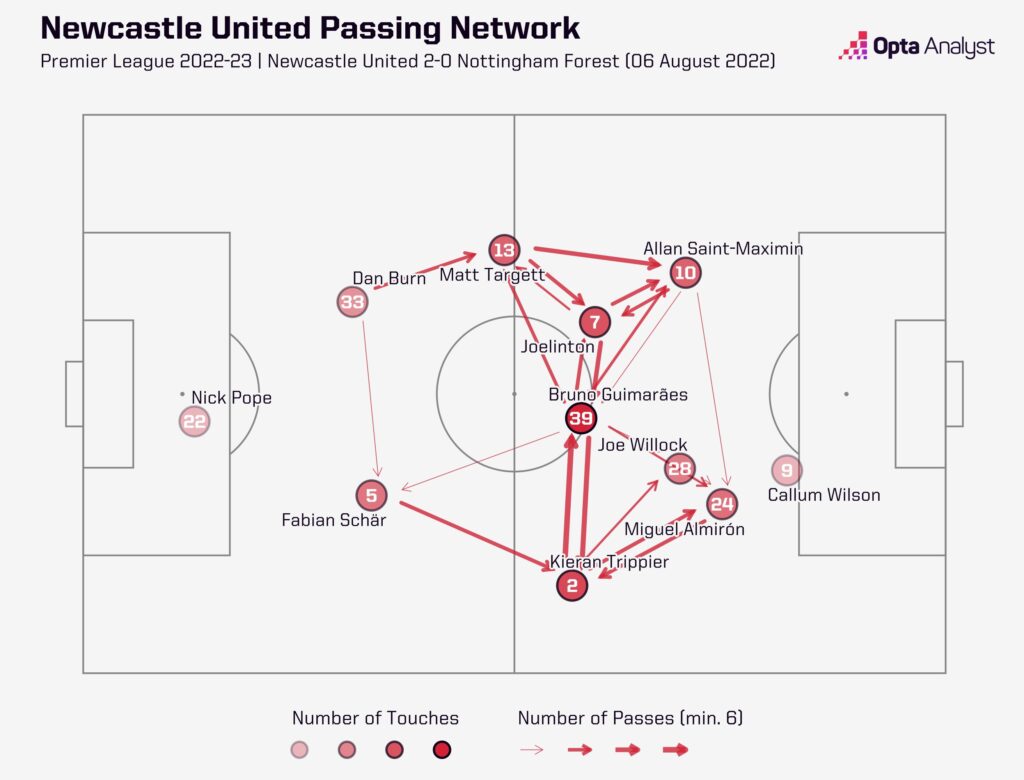
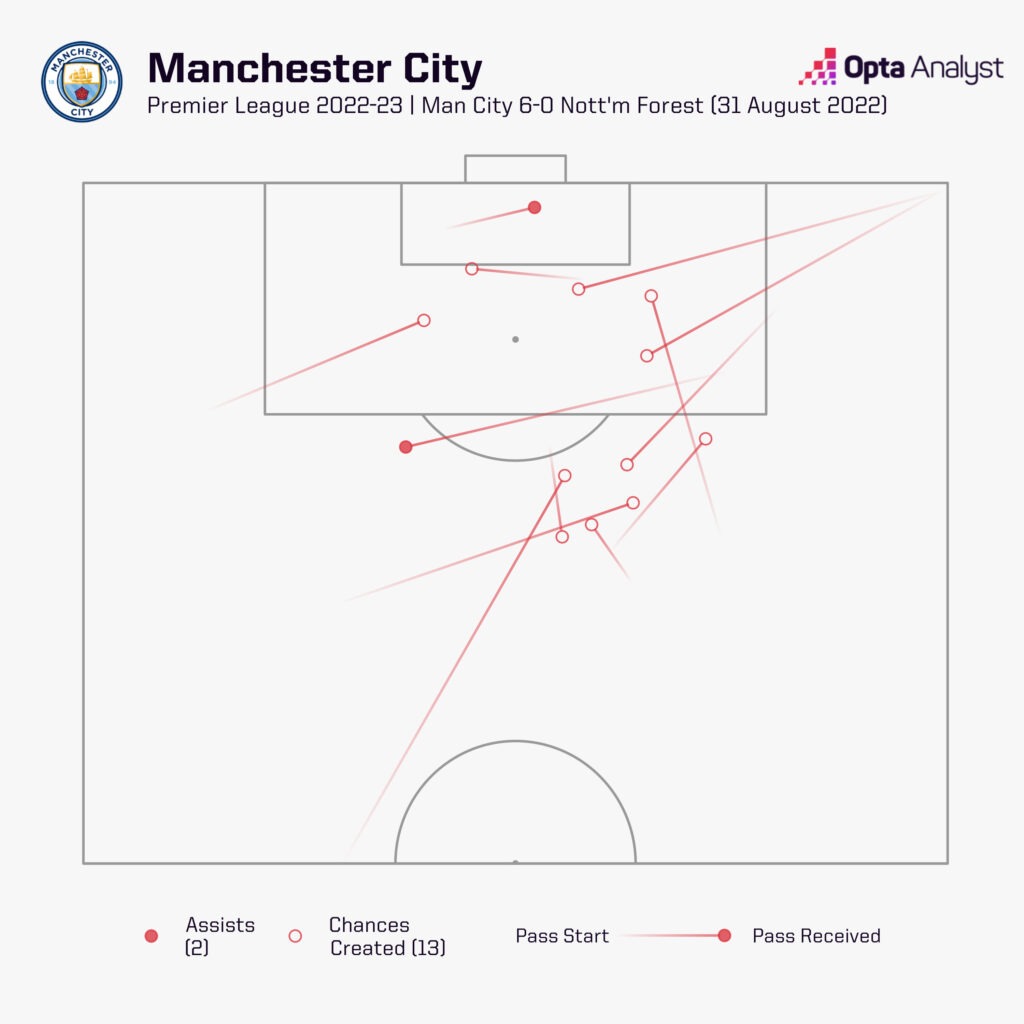
Cooper tried to shake things up with a move to a 4-2-3-1 for the trip to Leicester City in early October but, with Forest still piling forward, a disastrous 4-0 defeat left him on the brink with Rafa Benítez waiting in the wings.
Cooper needed a drastic change to plug the gaps in the middle.
Act 2: Give Me the Narrowest Formation You Have
Forest had two major tactical eureka moments this season and they both occurred against Aston Villa. The first was in the 1-1 draw at home to Steven Gerrard’s side in early October when, faced with the sack if results did not improve, Cooper threw everything out and replaced his previous tactics with a narrow blockade.
Battening down the hatches, Forest shifted to a narrow 4-3-3 formation (to patch up that porous midfield) and decided to let go of their expressive pretensions, dropping the defensive line deeper, stopping the high press, and generally moving towards a pragmatic version of defence-first counter-attacking football at odds with what we previously saw from Cooper teams.
This style and formation held for a nine-game period until a match against Southampton in early January and represents the second act of Forest’s season.
The move significantly reduced Forest’s attacking threat…

… but made them much harder to beat:

Although their away form remained poor – a theme throughout the season – in this second act Forest conceded just four goals from five matches at the City Ground, the pinnacle being a 1-0 victory over Liverpool that serves as the extreme point of their mid-season move to all-out defending.
With just 25% possession, Cooper picked three defensive midfielders – Cheikhou Kouyaté, Remo Freuler and Ryan Yates – to squeeze the middle, blocking Liverpool’s preferred passing route and patching up the exact area that had caused so many problems in the first seven matches:
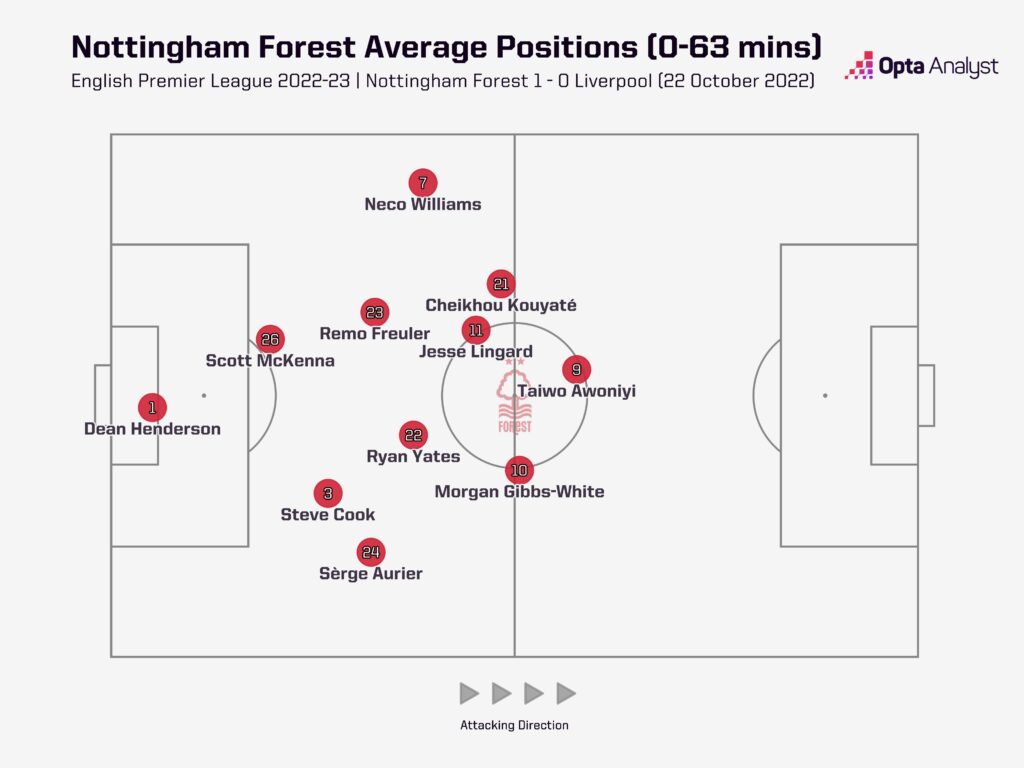
Act 3: No, That’s Too Narrow
By moving deeper and into a narrower shell from which to counter-attack, Forest had improved, although after 17 matches they still only had 14 points. Goals had dried up too much, so Cooper decided to change things again.
Act 3 is the most complicated. It began with Forest’s best patch of the season to date, with 10 points won from four Premier League matches in a 4-3-1-2, but injuries to Taiwo Awoniyi and then Chris Wood meant Cooper had to shift the formation slightly to a 4-3-2-1, which precipitated a significant downturn in form.
Throughout this third act Forest were more expressive and possession-focused, building back towards the style of football Cooper prefers to play. What we see across a number of metrics is Forest holding more of the ball and their creativity creeping back up, but at the expense of defensive solidity:
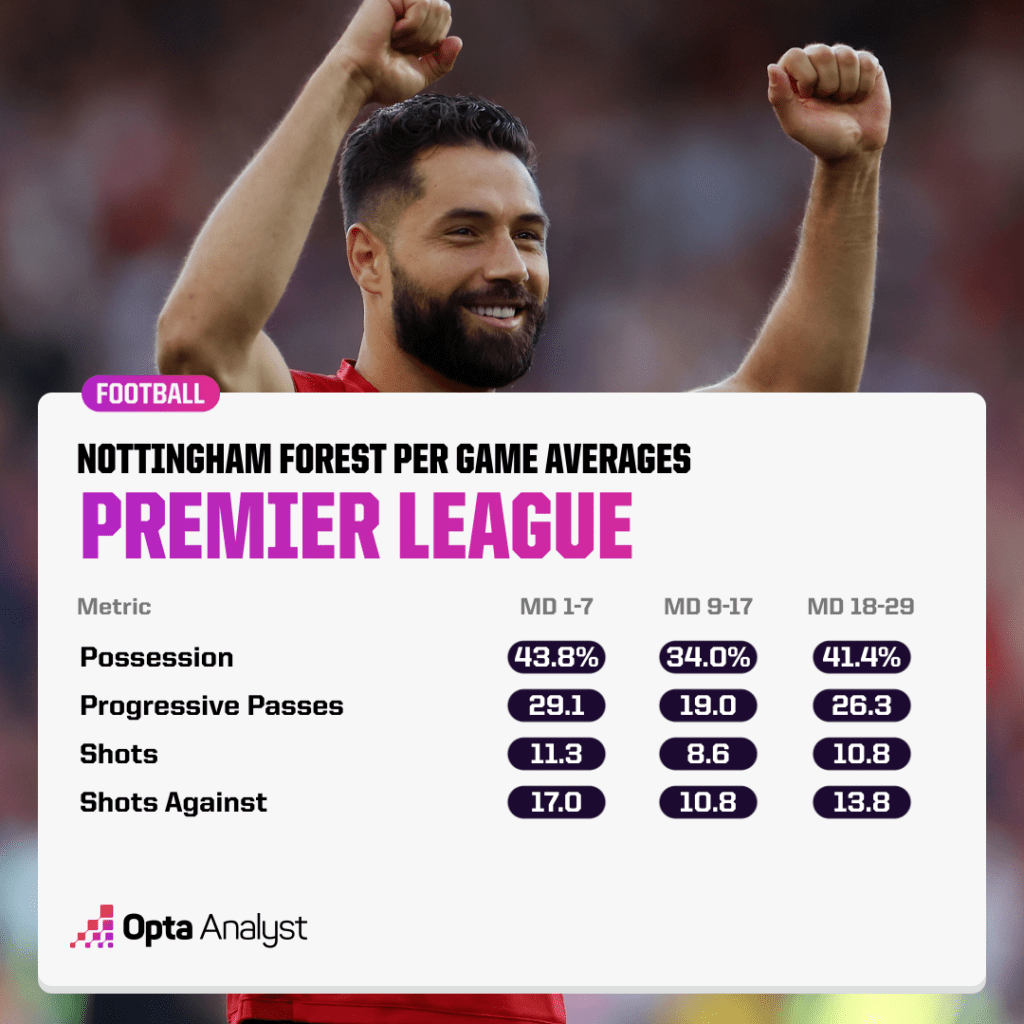
The statistical difference on the defensive side of things might only seem minor, but things got progressively worse once the 4-3-1-2 was replaced by a 4-3-2-1 – in which Forest secured three draws and no wins from eight matches.
The most likely explanation for this is that, with the Forest squad now settled, Cooper felt he could open things up a little to address their goalscoring woes, only to find that his formation was simply too narrow to cope.
The most interesting figure of all is the increased number of successful crosses made by their opponents, who continually tore down the flanks:
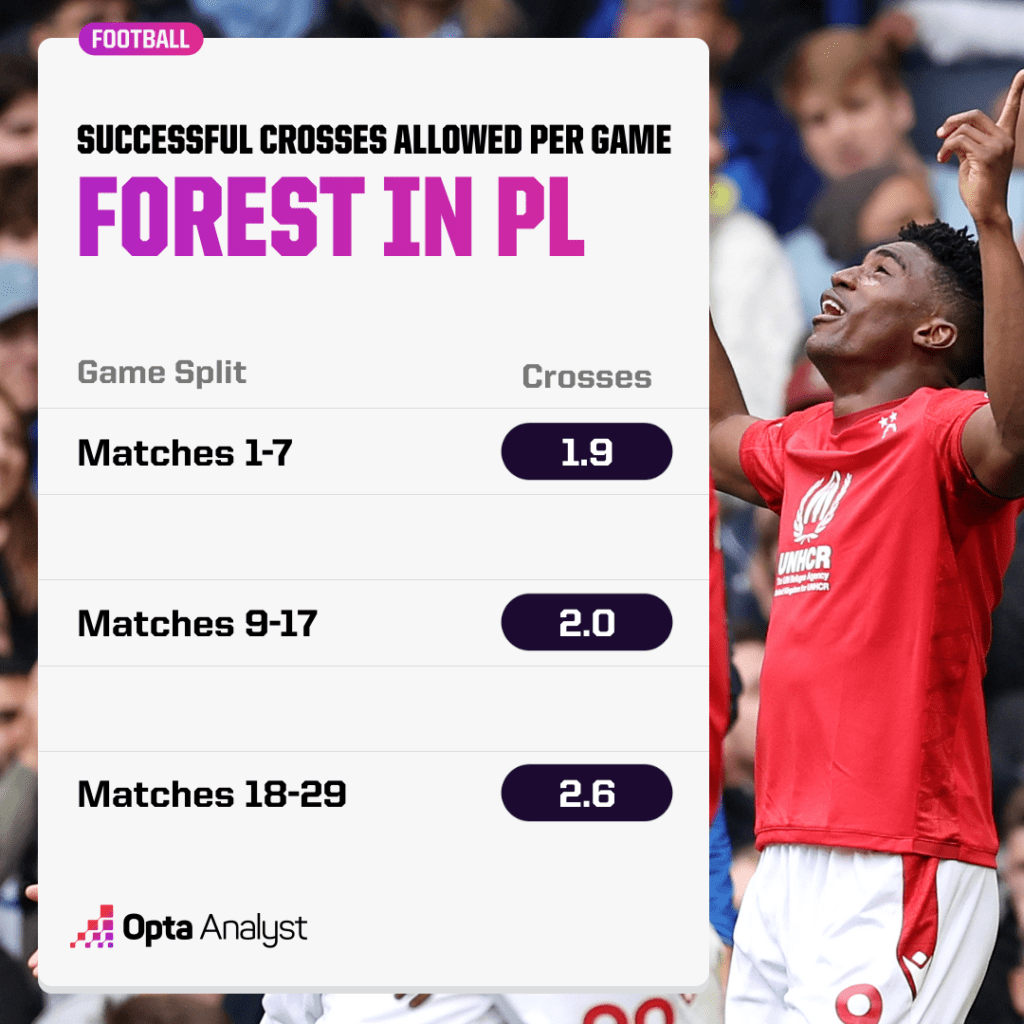
To take just one example, in a 4-0 defeat to West Ham in February, David Moyes fielded Saïd Benrahma and Jarrod Bowen wider than usual in order to isolate the Forest full-backs and use the wings to counter-attack Cooper’s flawed formation.
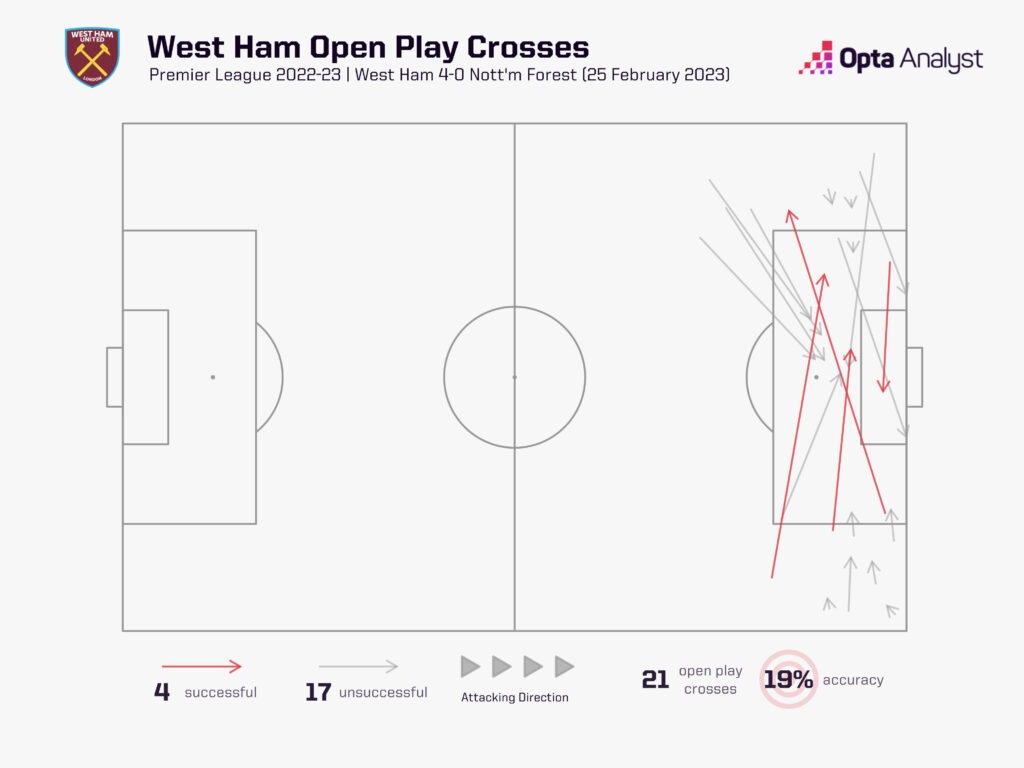
Act 4: Shut It Down
A 2-1 defeat to Leeds United (in which, quelle surprise, both Leeds goals were built down the wings) looked like the final straw. It was followed by a vote of confidence from owner Evangelos Marinakis that didn’t actually contain a vote of confidence:
“It is very clear that a lot of hard work needs to be done to address this urgently. Results and performances must improve immediately.”
Results didn’t, but performances did, thanks to Cooper’s second dramatic tactical shift of the season.
He returned to deep defensive football, but this time with his favoured 3-4-3 formation, meaning an even more conservative setup when the opposition had the ball.
Things started slowly, with three defeats from three tough games, but as the players learnt to shuffle across in a ruthless flat back five, the tide turned and Forest, winning 10 points from five matches, made it over the finish line.
On the one hand, the obvious difference was taking low-block football to the extreme:

But more importantly, starting from this low position meant Forest drew the opposition forward, in turn creating more counter-attacking opportunities via long balls up to their explosive front three of Gibbs-White, Awoyini, and Brennan Johnson or Danilo.
In their last six matches, Forest have – remarkably – scored 13 goals from 17 shots on target. By no statistical measure have they improved going forward, but arguably by racing through on the break – rather than attempting to build out – they are creating more high-quality chances:
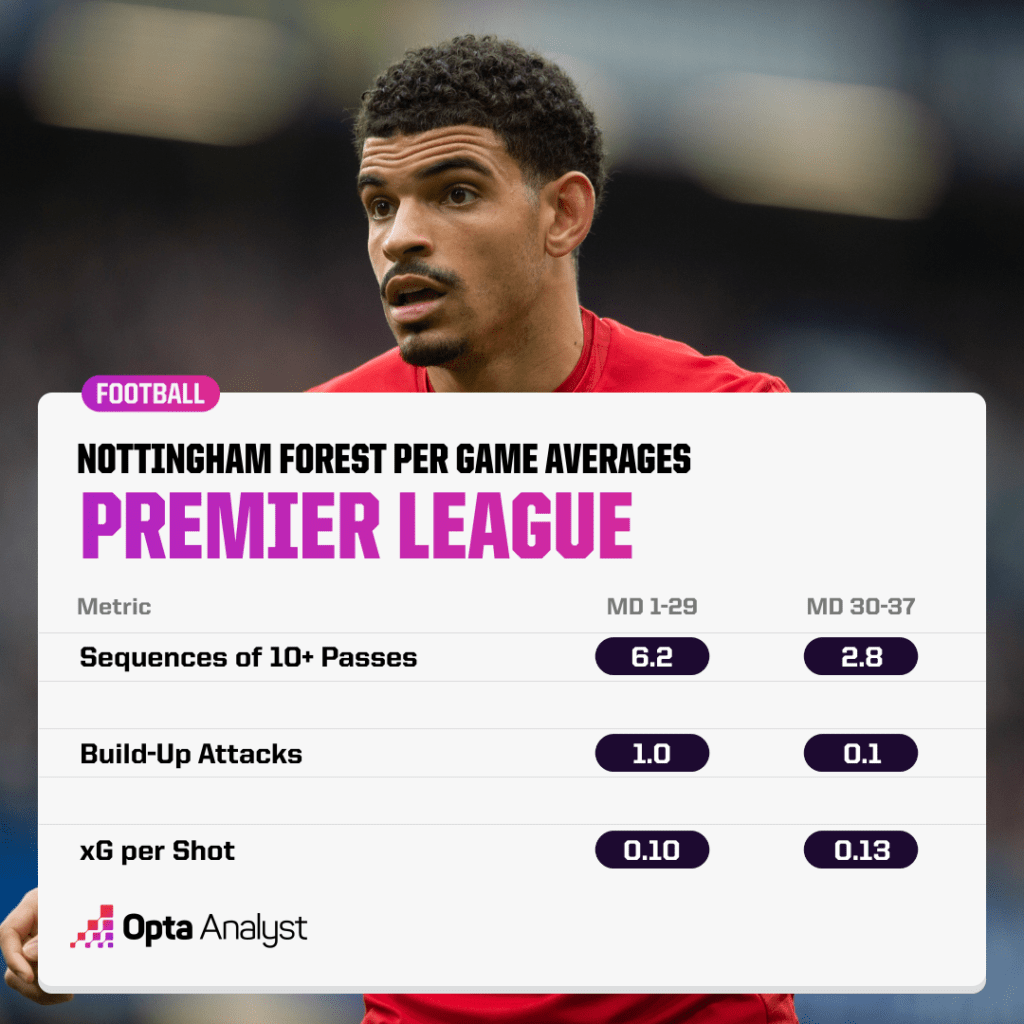
Or maybe it was simply a mixture of good luck in defence (their xG against has actually risen from 1.6 per game over the first 29 matches to 2.1 per game over the last eight) and great finishing once Awoniyi returned to action. He has scored five goals in his last three matches and, across the season, has maintained a 26.5% conversion rate in front of goal – which is second only to Erling Haaland of players with more than five goals.
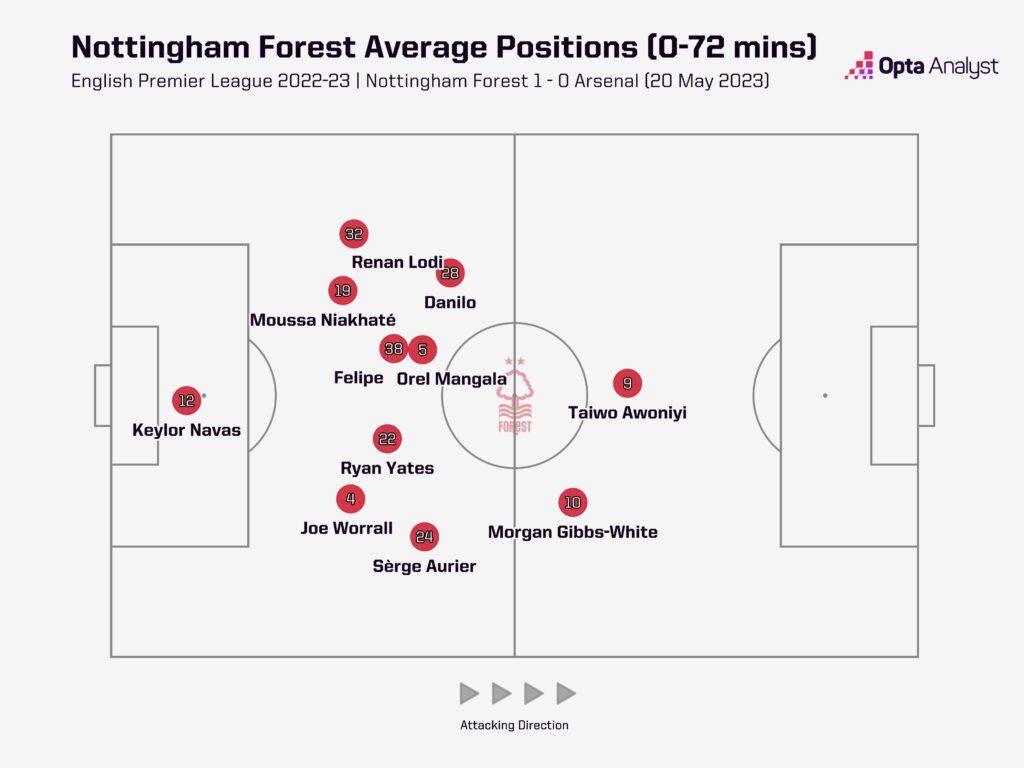
Nevertheless, it is hard to ignore what happened at the City Ground last weekend. The 1-0 win over Arsenal is ultimately what kept Forest up. There is little doubt, with 0.6 xG against and a season-low 19% possession, this game encapsulated the final destination of their tactical journey and of the down, up, down, and up-again learning curve of Cooper’s miraculous debut year in the Premier League.
Enjoy this? Subscribe to our mailing list to receive exclusive weekly content. And follow us on Twitter too.
